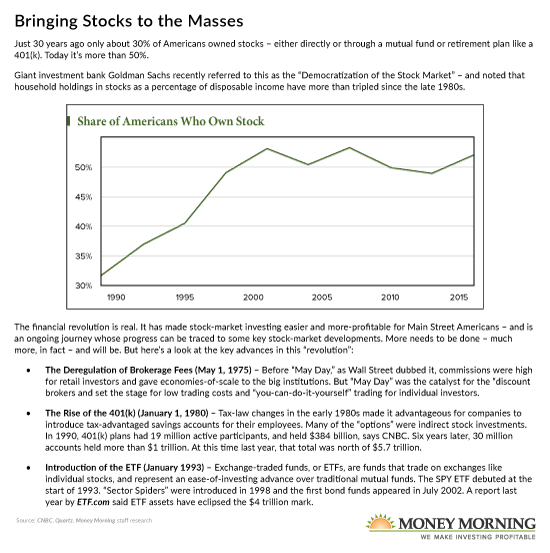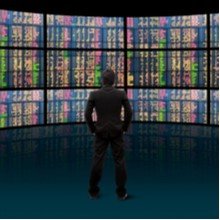Editor's Note: Almost no one realizes, but some of the most dangerous, portolio-wrecking stocks are also some of the most popular picks on the market. Our chief investment strategist is going live and shining a light on the specific stocks that should be nowhere near your portfolio. In this fast-paced lightning round event, he’ll also detail the stocks that every investor in the world should have in their portfolio right now. This event could revolutionize how you make money this year.
Dear Red Alert Reader,
You got $5?

What if I told you that was enough to get you started with stocks like Amazon ($3,160), Alphabet/Google ($1,527), Apple ($460), Nvidia ($460), or Microsoft ($210)?
The fact is, that's not only possible - it's actually easy to do.
Welcome to the "Fractional Shares Revolution."
It's a Brave New World in the stock market - one that's leveling the playing field like never before.
It's the bridge across the moat.
It's the passkey to the gilded penthouse.
It's the map that will guide you to a life of financial security and meaningful wealth.
And it's a journey you can begin with pocket change.
Mutual funds, ETFs, and other "easy access" investing vehicles are great.
But if you want to retire rich, individual stocks are the way you want to go.
There's no longer any excuse for not being in the stock market, for not staking your claim to some of the riches to be mined there. The barriers to entry have all been dismantled, though it took a long time.
Invest in stocks to retire rich.
Here today, I'll give you the full lowdown on this "revolution" - one that's been revved up by Robinhood Trading Inc.
I'll show you how to use it to your advantage, to empower yourself.
And I'll spotlight some stocks to start with...
Bull Markets and Bullish Trends
Let me tell you: My first job on Wall Street was with the Chicago Board Options Exchange (CBOE) in the early 1980s - just before the start of the Great Bull Market.
So I've been doing this for a very long time.
And I've never been more excited about stocks, never been more excited about the growing number of opportunities I see each and every day, and never been more excited about the shot regular investors have at life-changing wealth.
Much of this is due to the "Fractional Shares Revolution."
Inventiveness - and companies like Robinhood - are fueling the revolution right now.
But the seeds were sown long ago - even before I started out as an investor and trader.
Times were that Main Street investors faced a lot of obstacles that made it difficult and expensive to buy individual stocks.
Buy this, not that: The best (and worst) stocks in America. Get the details.
Back then, if you wanted to buy a stock, you were almost compelled to buy a "round lot" - typically 100 shares, 500 shares, or 1,000 shares.
Transaction fees were high to start with, and folks who bought less than that round lot of a hundred, five hundred, or a thousand shares additionally got slapped with an "odd-lot fee."
Those barriers began to fall - albeit slowly.
Eradicating Boundaries
Congress first paved the way for millions of Americans to tap into the stock market when it passed the Employee Retirement and Income Security Act of 1974. ERISA created Individual Retirement Accounts - IRAs - so retirement money could be invested in stock funds on a tax-free basis.
Over time, individual investors increasingly opened IRA accounts in brokerage houses, with the most-savvy investors choosing to open "self-directed" IRAs that had them picking specific stocks, bonds, ETFs, real estate, and other investments they buy and sell in their accounts.
From a base of essentially zero in 1974, assets held in IRAs zoomed to $1.1 trillion in 1994. And they've increased about 10% a year ever since. By March of this year, IRA assets had reached $9.5 trillion - about a third of the $28.7 trillion held in retirement plans of all types, says the Investment Company Institute (ICI).

Fortunately, and most importantly, on the path to equal stock market access, in 1975, the U.S. Securities and Exchange Commission abolished "fixed commissions" - the essentially illegal price-fixing scheme the American brokerage industry established to enrich its snooty cadre of market-access gatekeepers.
Known as "May Day" because the new rules went into effect on May 1, 1975, this act of regulatory insurrection did exactly what the SEC, the investing public, and Charles Schwab, who championed May Day, wanted: It gave rise to the discount-brokerage business.
Today there are dozens of discount brokerages. And the Charles Schwab Corp. (NYSE: SCHW) just happens to be the largest, boasting more than $4 trillion in client assets and more than 12.5 million active accounts.
The battle front in that discount-brokerage slice of the Revolution is suddenly heating up.
Schwab recently announced an all-stock, $26 billion bid for rival discounter TD Ameritrade Holding Corp. (NASDAQ: AMTD), which has more than 11 million accounts and over $1 trillion in client assets.
Meanwhile, Morgan Stanley (NYSE: MS), one of the country's largest wealth managers, is spending a cool $13 billion to grab another top-tier discount brokerage: E*TRADE Financial Corp. (NASDAQ: ETFC), which has 5.2 million accounts and nearly $1 trillion in client assets.
What was the catalyst for this staccato bout of dealmaking?
You guessed it - Robinhood, the cheeky trading upstart whose surge in popularity has pushed it to the top of the trading heap.
The Little Broker That Could
The Menlo Park, Calif.--based Robinhood has been around since 2013.
But it fired the Revolution's "first shot" last year.
That's when Robinhood cut its trading commission charges to zero.
It wasn't the first discounter to offer zero-commission trading (that was M1 Finance in 2017). But Robinhood has been grabbing headlines and has become the darling of millennials.
And that's turned it into a trading juggernaut.
At last count, Robinhood had 13 million accounts, holding an average of $2,500 each. It saw 4.3 million daily average (DART) trades in June - more than Schwab and E*TRADE combined, and more than any other single publicly traded brokerage, says a report released just this past week.
So when Robinhood cut commissions, pretty much every other discount had to follow suit.
Now anyone can trade for free.
That's not just great - it's empowering.
It means each of us has more types of trading vehicles than ever before - 401(k) plans, mutual funds, ETFs, and more.
And now, individual stocks.
Even fractional pieces of individual stocks.
Let me show you why.
Wealth Building for Every Budget
Having shattered virtually every "barrier to entry" for purchasing individual stocks, only one barrier remained - until it didn't.
Stock prices have been rising, especially the most popular and most profitable stocks - meaning that even the purchase of a single share could be prohibitively expensive, if not downright impossible.
MONEY MORNING’S FIRST-EVER STOCK PICKING LIGHTNING ROUND
FIRST-EVER STOCK PICKING LIGHTNING ROUND
Money Morning is launching its first-ever stock-picking lightning round event. Our chief investment strategist will be flying through stocks – more than 50 to be exact – telling you which to consider buying NOW and which to drop like a ton of bricks. These picks will be coming fast and furious. (Make no mistake: This event will be rapid-fire – you will want to take notes.) Watch now.
Apple Inc. (NASDAQ: AAPL) costs $460 a share, and Tesla Inc. (NASDAQ: TSLA) costs $1,600 (though both stocks are headed for splits). Netflix Inc. (NASDAQ: NFXL) is fetching $480.
As we mentioned here at the outset, grabbing some Alphabet Inc./Google (NASDAQ: GOOGL) will cost you $1,520 and Amazon.com Inc. (NASDAQ: AMZN) $3,160.
And Berkshire Hathaway Inc. (NYSE: BRK.A) - the investment vehicle of Warren Buffett and one of the best-performing stocks of all-time - that will set you back $318,000 per share.
Or, you could buy a "slice" - or fraction - of a share of any of those stocks, for any amount you want to invest: Maybe $50, $100, or $1,000 - or even a mere $5, if that's how you want to roll.
Fractional shares are now mainstream thanks to almost every brokerage offering them - most at zero commission, by the way.
They're not new ("DRIP" plans have done this for years). But they are newly popular.
That's the "Fractional Shares Revolution."
Now brokerages offer fractional shares, because they can, because buying fractional shares is affordable, because a lot of new accounts are being opened by investors and traders who want to plunk down a set amount of money to buy whatever amount of shares (or fractions of shares) they can - for whatever amount they apply.
Now there's no excuse for not opening a brokerage account and getting started in the stock market; you don't even have to buy a single share of stock to get into the game.
It doesn't matter that you own a fraction of a share - if the stock price goes up 2%, 50%, 100%, or more, the value of your fractional shares goes up just as much.
And, yes, if you own a fractional share of a company that pays a dividend, you get paid a fraction of that dividend - which, of course, you could use to buy more fractional shares.
You Have the Edge on Wall Street
The knock on Main Street investors has always been that they don't know what they're doing - that they buy too late and sell too early - presumably because they lack the knowledge, experience, and inside-track insights that the investment pros seem to possess.
In short, retail investors are followers and not leaders.
But that's not true anymore.
For the first time in my 40-year career as an institutional player, I've watched as professional investors had to chase the retail investors whose buying drove stocks higher.
It was retail investors - including a lot of Robinhood account holders, discount-brokerage clients paying zero commissions, and new-to-the-game investors and traders buying fractional shares - who bought stocks during the market's nadir back in March, lifted it from its coronavirus lows, and continue to drive it higher and higher.
And they keep buying. Retail buying has been the driving force behind the Nasdaq Composite's ascent to new all-time highs, with retail's incessant buying of Apple, Amazon, Tesla, and other "tech" stocks, including millions of orders to buy fractional shares.
Has the "democratization" of the market changed what moves markets? Are retail accounts and fractional-share buyers the tail wagging the dog?
The jury's out on all that, on account of the new playing field still being marked off and there being no rules.
But that really doesn't matter.
The true power of the "Fractional Shares Revolution" is the long-term, wealth-creating potential it has placed in the palms of your hands.
And there's no reason - no excuse - not to stake your claim. Even with as little as $5.
Open an account.
Start buying the high-priced stocks I've mentioned - each of them, and all of them.
Start with whatever you have. Add money to that account whenever you have some to spare.
And keep buying, no matter what the stock market does - up, down, or sideways.
You're in control of your own financial future.
Welcome to the "Fractional Shares Revolution."
It can make you rich.
To get you started – right here, right now – I'm sharing with you a run-through of 50-plus stocks you should know about.
Some are buys, some are sells. You'll see.
I won't hold back – I'll show you prices, tickers, and company names.
Be ready to take notes – and then start buying. Go here to get my list.


